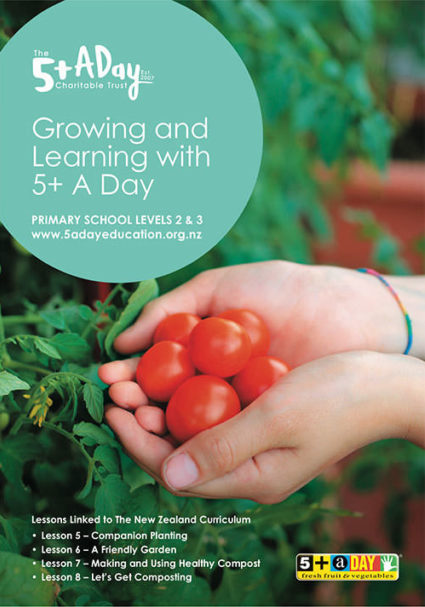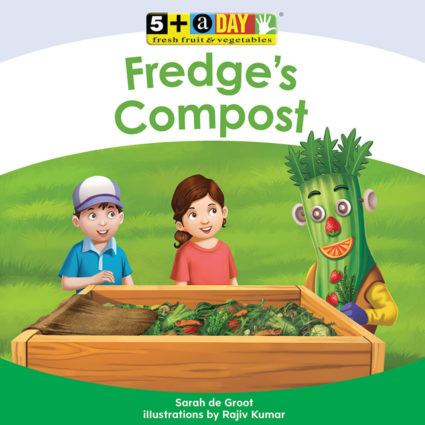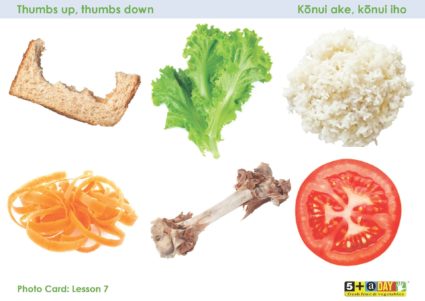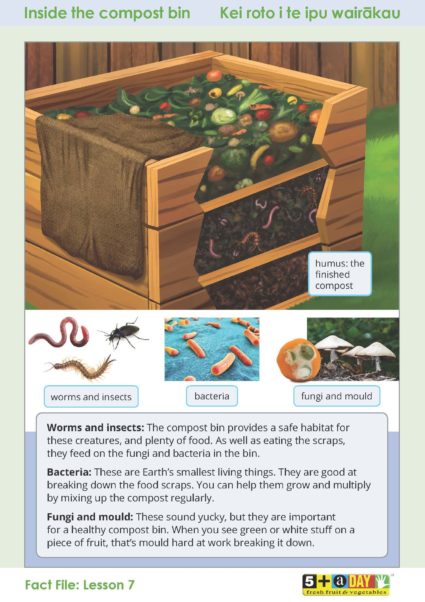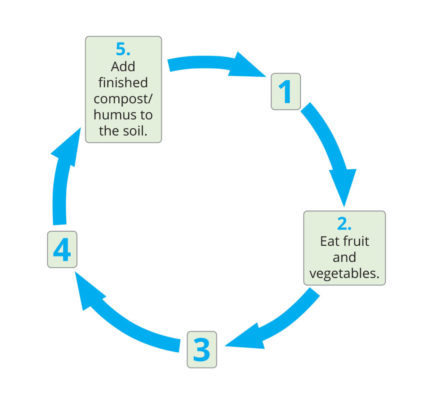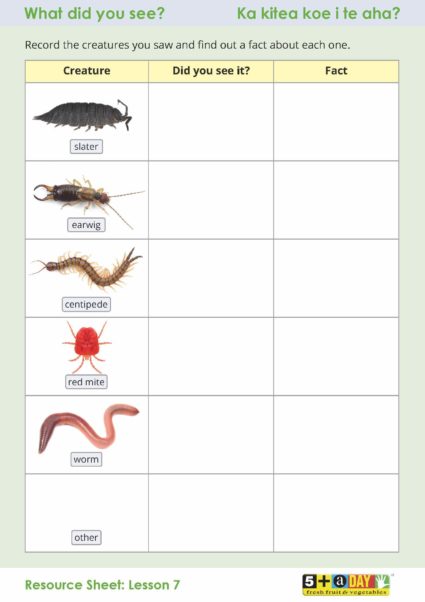Primary
Lesson 7: Making and Using Healthy Compost
In this lesson, students will explore the importance of composting and come to an understanding of what makes good compost. In Lesson 2, students will make and observe the changes that occur as organic material is broken down in the composting process.

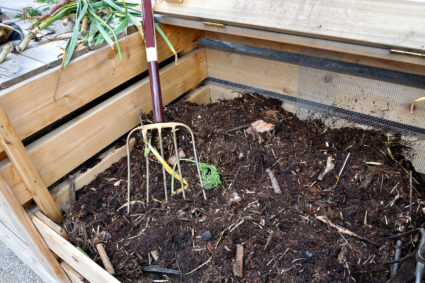
This lesson is featured in our printed resource; Book 2: Growing and Learning with 5+ A Day, Levels 2 & 3.
Order the print version here or download here to print yourself.
Learning Intentions
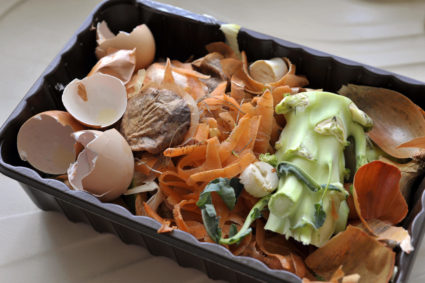
Students will:
- learn that compost is an important way to recycle nutrients back into the soil for plant growth and creating a disease resistant, healthy soil
- learn that the composting process relies on the correct environment and the action of fungi, bacteria, and invertebrates.
Possible Achievement Objectives
Science: Level 2
PROPERTIES AND CHANGES OF MATTER
Students will:
- observe, describe, and compare physical and chemical properties of common materials and changes that occur when materials are mixed, heated, or cooled.
Science: Level 3
ECOLOGY
Students will:
- explain how living things are suited to their particular habitat and how they respond to environmental changes, both natural and human induced.
Preparation
What You Need
- eBook: Fredge’s Compost
- Photo Card: Thumbs up, thumbs down/Kōnui ake, kōnui iho
- A bag of leaf litter or natural compost from a bin
- A sheet of white card
- Kitchen tongs, white bowl
- Magnifying glass
- Fact File: Inside the compost bin/Kei roto i te ipu wairākau
- Resource Sheet: What did you see?/Ka kitea koe i te aha?
Additional Resources
- Get Your Hands Dirty by Karen Phelps, School Journal Part 1, No 4, 2009
Key Vocabulary
Unfamiliar concepts and vocabulary should be used and defined simply in context:
bacteria/huakita: tiny organisms that help with breaking down living things; you need a microscope to see them
fungi/hekaheka: helps to decompose, or break down, plant, animal, and other living matter; mushrooms and mould are fungi
humus/paraumu: the nutrient rich, soil-like end product of the composting process
nutrients/taiora: chemicals or minerals in the soil, which plants take in through their roots and use as food
Learning Opportunity
This lesson will introduce the students to the environmental importance of composting, and how this helps create healthy soil in order to grow fresh fruit and vegetables. Students will also explore the composting process, looking closely at what happens over time in a compost bin.
The Lesson
eBook: Fredge’s Compost
Begin the lesson by sharing the eBook, Fredge’s Compost (click on the cover of the eBook). There is audio for this story that you can use, or students can take turns to read the text
The focus of the eBook is to reinforce information about correct composting and the value of composting for soil health. For information on using 5+ A Day eBooks, click here.
There are two interactive activities that follow the eBook. They work on a computer, a tablet, or an IWB. They can be used during or at the end of the lesson or in choosing time to reinforce key information from the story. Students will get the most from these activities if you model them first and explain the actions required and the aims of the activity. Then students can do them independently or in pairs.
For Activity 7, help Fredge make compost by dragging the correct items into the compost bin: banana, apple, carrot, spinach. For Activity 8, to show how compost is made, drag the items into the compost bin in the correct order: food scraps, rotting food, compost creatures, compost.
- What important things did we learn in this book?
- Were Niko and Rae helping to make good compost? Why?
Ask the students to describe what happened when Niko and Rae put rice and meat into Fredge’s compost bin.
- What would happen if they kept doing that? (There would be lots of mice and flies in Fredge’s garden.)
- Yes, there would lots of pesky mice and flies./Ae, he maha rawa ngā kiore me ngā rango kirearea hoki.
Photo Card: Thumbs up, thumbs down
Show the students the Photo Card: Thumbs up, thumbs down/Kōnui ake, kōnui iho. (Click on the image to enlarge and download. You can display it using a data projector or share printouts in small groups.)
- These photos shows some leftovers from preparing dinner. Give me a thumbs up or a thumbs down as I point to each thing. Should I put it in my compost bin?
Point to each item of food in turn, and have the students give a thumbs up or a thumbs down, and explain their reasons. Discuss any differences of opinion.
Fact File: Inside the compost bin/Kei roto i te ipu wairākau
- If you poked around inside the compost bin, what might you see, apart from the scraps?
Make a list of the students’ suggestions.
Now use the tongs to place a small pile of the leaf litter onto the sheet of card. Use the tongs to carefully lift off the larger matter, so the smaller pieces can be seen. This will make it easier to spot any living things.
Note: Don’t let the students touch or sniff the compost. Some of the bacteria can cause Legionnaires' Disease, which is a pneumonia caused by bacteria commonly found in water and soils, including potting mix and compost, so always use the tongs to handle it.
- What can you see?/He aha tāu e kitea ai?
As you poke around carefully, you may see tiny creatures such as red mites, black beetles, slaters, earwigs, and centipedes against the white card background. List the ones that the students know, and write a description of any unknown ones.
You could carefully place one of each kind of creature into a white bowl so students can take a closer look using the magnifying glass.
Now share the Fact File: Inside the compost bin/Kei roto i te ipu wairākau (click on the image to enlarge, download, and print).
Discuss the information about fungi, insects, and bacteria, and how each contributes to a healthy compost bin. The discussion needs to explore how the compost works its way to the bottom of the bin. By the time it gets there, it is rich and healthy humus, which is ready to go on the garden to add nutrients that help plants grow.
- How does the compost bin work?/He aha te whakaritenga mo ngā ipu wairākau?
- What happens as the fungi, insects, and bacteria do their work? (The scraps are broken down.)
- When is the compost ready? What should it look like? (Humus should look brown and soil-like.)
- What do you do with the finished compost? (Put it on the garden to add nutrients to the soil.)/Ka aha koe ki te wairākau otinga? (Whakatō ki te māra kia kinakahia ngā taiora ki te one.)
The compost cycle
To reinforce the cyclical nature of composting, draw the diagram below on the board and have the students help you fill in the following missing stages:
1. Grow fresh fruit and vegetables in healthy soil.
3. Save fruit and vegetable scraps.
4. Use scraps to make compost.
Reflect on the Learning
After the students have had the opportunity to look at any creatures you have found and made notes, give them each a copy of the Resource Sheet: What did you see?/Ka kitea koe i te aha? You can click on the image and download the active PDF for them to complete (they can type directly into the spaces provided) or print the sheet for them to work on. Explain that they can use this to choose some of the creatures they saw and to find out a fact about each one. This is also a time to reflect on the learning and signal the focus for the next lesson, where students will carry out a long-term practical exercise to observe the changes that occur during the composting process.
